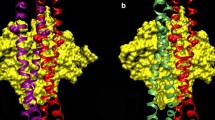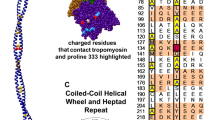Abstract
Contraction of skeletal and cardiac muscle is controlled by Ca2+ ions via regulatory proteins, troponin (Tn) and tropomyosin (Tpm) associated with the thin actin filaments in sarcomeres. In the absence of Ca2+, Tn-C binds actin and shifts the Tpm strand to a position where it blocks myosin binding to actin, keeping muscle relaxed. According to the three-state model (McKillop and Geeves Biophys J 65:693–701, 1993), upon Ca2+ binding to Tn, Tpm rotates about the filament axis to a ‘closed state’ where some myosin heads can bind actin. Upon strong binding of myosin heads to actin, Tpm rotates further to an ‘open’ position where neighboring actin monomers also become available for myosin binding. Azimuthal Tpm movement in contracting muscle is detected by low-angle X-ray diffraction. Here we used high-resolution models of actin-Tpm filaments based on recent cryo-EM data for calculating changes in the intensities of X-ray diffraction reflections of muscle upon transitions between different states of the regulatory system. Calculated intensities of actin layer lines provide a much-improved fit to the experimental data obtained from rabbit muscle fibers in relaxed and rigor states than previous lower-resolution models. We show that the intensity of the second actin layer line at reciprocal radii from 0.15 to 0.3 nm−1 quantitatively reports the transition between different states of the regulatory system independently of the number of myosin heads bound to actin.





Similar content being viewed by others
References
Behrmann E, Muller M, Penczek PA, Mannherz HG, Manstein DJ, Raunser S (2012) Structure of the rigor actin–tropomyosin–myosin complex. Cell 150:327–338. doi:10.1016/j.cell.2012.05.037
Bershitsky SY, Ferenczi MA, Koubassova NA, Tsaturyan AK (2009) Insight into the actin-myosin motor from X-ray diffraction on muscle. Front Biosci 14:3188–3213. doi:10.2741/3444
Chen LF, Winkler H, Reedy MK, Reedy MC, Taylor KA (2002) Molecular modeling of averaged rigor crossbridges from tomograms of insect flight muscle. J Struct Biol 138:92–104
Gordon AM, Homsher E, Regnier M (2000) Regulation of contraction in striated muscle. Physiol Rev 80:853–924
Haselgrove JC (1972) X-ray evidence for a conformational change in the actin-containing filaments of vertebrate striated muscle. The Mechanism of Muscle Contraction. Cold Spring Harbor Laboratory; Cold Spring Harbor, NY, pp 341–352
Huxley HE (1972) Structural changes in the actin- and myosin-containing filaments during contraction; the mechanism of muscle contraction. Cold Spring Harbor Laboratory, Cold Spring Harbor, pp 361–368
Klug A, Crick FHC, Wyckoff HW (1958) Diffraction by helical structures. Acta Cryst 11:199–213
Koubassova NA, Tsaturyan AK (2002) Direct modeling of X-ray diffraction pattern from skeletal muscle in rigor. Biophys J 83:1082–1097
Koubassova NA, Bershitsky SY, Ferenczi MA, Tsaturyan AK (2008) Direct modeling of X-ray diffraction pattern from contracting skeletal muscle. Biophys J 95:2880–2894
Kraft T, Mattei T, Radocaj A, Piep B, Nocula C, Furch M, Brenner B (2002) Structural features of cross-bridges in isometrically contracting skeletal muscle. Biophys J 82:2536–2547
Kress M, Huxley HE, Faruqi AR, Hendrix J (1986) Structural changes during activation of frog muscle studied by time-resolved X-ray diffraction. J Mol Biol 188:325–342
Kubasova NA (2008) A comparison of the models of a thin filament in the muscle with low-angle X-ray diffraction data obtained for the relaxed rabbit muscle. Biofizika 53:936–942
McKillop DF, Geeves MA (1993) Regulation of the interaction between actin and myosin subfragment 1: evidence for three states of the thin filament. Biophys J 65:693–701
Moore JR, Campbell SG, Lehman W (2016) Structural determinants of muscle thin filament cooperativity. Arch Biochem Biophys 594:8–17
Nevzorov IA, Levitsky DI (2011) Tropomyosin: double helix from the protein world. Biochemistry (Mosc). 76:1507–1527
Pirani A, Vinogradova MV, Curmi PM, King WA, Fletterick RJ, Craig R, Tobacman LS, Xu C, Hatch V, Lehman W (2006) An atomic model of the thin filament in the relaxed and Ca2+-activated states. J Mol Biol 357:707–717
Poole KJ, Lorenz M, Evans G, Rosenbaum G, Pirani A, Craig R, Tobacman LS, Lehman W, Holmes KC (2006) A comparison of muscle thin filament models obtained from electron microscopy reconstructions and low-angle X-ray fibre diagrams from non-overlap muscle. J Struct Biol 155:273–284
Spudich JA, Huxley HE, Finch JT (1972) Regulation of skeletal muscle contraction. II. Structural studies of the interaction of the tropomyosin-troponin complex with actin. J Mol Biol 72:619–632
Tsaturyan AK (2002) Diffraction by partially occupied helices. Acta Crystallogr A 58:292–294
Tsaturyan AK, Koubassova N, Ferenczi MA, Narayanan T, Roessle M, Bershitsky SY (2005) Strong binding of myosin heads stretches and twists the actin helix. Biophys J 88:1902–1910
Tsaturyan AK, Bershitsky SY, Koubassova NA, Fernandez M, Narayanan T, Ferenczi MA (2011) The fraction of myosin motors that participate in isometric contraction of rabbit muscle fibers at near-physiological temperature. Biophys J 101:404–410
Vainstein BK (1966) Diffraction of X-rays by chain molecules. Elsevier, Amsterdam
Vibert P, Craig R, Lehman W (1997) Steric-model for activation of muscle thin filaments. J Mol Biol 266:8–14
Vinogradova MV, Stone DB, Malanina GG, Karatzaferi C, Cooke R, Mendelson RA, Fletterick RJ (2005) Ca(2 +)-regulated structural changes in troponin. Proc Natl Acad Sci USA 102:5038–5043
Von der Ecken J, Mülle M, Lehman W, Manstein DJ, Penczek PA, Raunser S (2015) Structure of the F-actin-tropomyosin complex. Nature 519:114–117
Acknowledgments
This work was supported by grants from the Russian Foundation for Basic Research 15-04-02174 (to NK) and 16-04-00693 (to AT) and by ESRF. Authors thank Mr J. Gorini for excellent technical support.
Author information
Authors and Affiliations
Corresponding author
Rights and permissions
About this article
Cite this article
Koubassova, N.A., Bershitsky, S.Y., Ferenczi, M.A. et al. Tropomyosin movement is described by a quantitative high-resolution model of X-ray diffraction of contracting muscle. Eur Biophys J 46, 335–342 (2017). https://doi.org/10.1007/s00249-016-1174-6
Received:
Revised:
Accepted:
Published:
Issue Date:
DOI: https://doi.org/10.1007/s00249-016-1174-6




